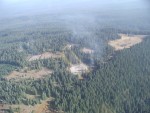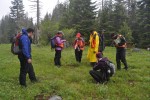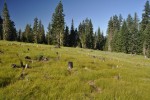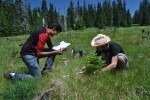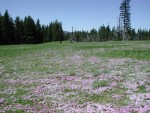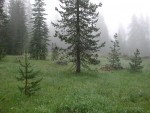The encroachment of grasslands by woody plants is occurring globally, with profound ecological consequences. In the Pacific Northwest, the invasion of mountain meadows by conifers is threatening biological diversity at both local and regional scales. Although small and often isolated, meadows contribute disproportionately to the diversity of this largely forested landscape. Recent encroachment—reflecting changes in climate or disturbance regime—has reduced the extent of meadows by more than 50 percent in parts of the Cascade and Coast Ranges, raising widespread concern and interest in management to restore and conserve these important habitats. Toward this end, scientists and resource specialists with the HJ Andrews Experimental Forest (AND) Long Term Ecological Research (LTER) program and the Willamette National Forest (WNF) initiated a research-management collaboration devoted to the ecology and management of Cascade meadows. A 100- hectare mosaic of conifer-invaded meadows at Bunchgrass Ridge was identified as a model system for experimentation and learning. The primary goals were to enhance understanding of the causes and consequences of tree encroachment; to test methods for reversing its effects; and to apply this knowledge to restoration of meadows throughout the Cascades. Bunchgrass Ridge now serves as a focal site for research, education and outreach on mountain meadow ecology and restoration. In this article we offer an overview of our research and educational activities.
Our initial studies reconstructed the history of tree encroachment and established an ecological baseline for a large-scale restoration experiment. Patterns of tree establishment revealed weak relationships with climate, but strong interactions within and between species that accelerated conversion of meadow to forest in the mid- to late 1900s (Halpern et al. 2010; Rice et al. 2012). Chronosequence studies indicate that conifers—grand fir in particular—exert strong control on meadow vegetation, resulting in rapid replacement of meadow by forest understory species within a few decades of tree establishment (Haugo & Halpern 2007, 2010). Moreover, most meadow species lack a persistent seed bank, precluding the potential for restoration through a storage effect (Lang & Halpern 2007).
Early results of our large-scale restoration experiment illustrate that tree removal benefits meadow species at the expense of forest herbs. However, fire does not appear critical to this process (Halpern et al. 2012). Although burning of woody fuels is necessary to reduce fire hazard, tree removal may be sufficient to initiate meadow reassembly. Removal of trees also enhances gopher activity and the resulting small-scale disturbances that regulate community structure in natural meadows (Case et al. 2013). Our results also suggest that the effects of encroachment can be reversed in forests of a wide range of ages, from recently established to more than a century old.
At the same time, our results raise uncertainty about longer term recovery of these systems following tree removal. First, increases in cover and richness of meadow species have slowed after eight years, and many species remain absent or under-represented relative to adjacent uninvaded meadows. This suggests that reassembly may be limited by seed dispersal, at least in the short term. Second, portions of some plots have become dominated by a highly competitive native sedge that may restrict further colonization of meadow species. Finally, reestablishment by conifer seedlings, although sparse at present, can lead to a more distributed source of seeds, thus speeding the reinvasion process—as with previous invasions of these meadows. Longer-term observations combined with small-scale experiments are needed to identify the factors that regulate community reassembly, including seed dispersal, competitive exclusion by initially establishing species, and changes in soil properties resulting from long-term presence of conifers.
Resource managers with WNF, who are active partners in this research, have assisted with the experimental design, implementation of the treatments, and sharing of information through field tours, workshops, and newsletters. Undergraduate and graduate training have also been integral to this research, with students serving on field crews and conducting independent research leading to theses and publications. During summer 2013 we hosted a particularly large and diverse group that included a crew of four undergraduates, a student in the National Science Foundation’s (NSF) Research Experiences for Undergraduates (REU) program, two students in the NSF‘s Research Assistantships for High School Students (RAHSS) program, a French student on a summer internship, a high school teacher in the NSF’s Research Experience for Teachers (RET) program, and a US Forest Service employee. The result was a summer filled with research, training, and sharing of cultural experiences.
References (*student publication)
*Case, M.F., C.B. Halpern & S.A. Levin. 2013. Contributions of gopher mound and casting disturbances to plant community structure in a Cascade Range meadow complex. Botany 91:555-561.
Halpern, C.B., R.D. Haugo, J.A. Antos, S.S. Kaas & A.L. Kilanowski. 2012. Grassland restoration with and without fire: evidence from a tree-removal experiment. Ecological Applications 22:425-441.
*Rice, J. M., C.B. Halpern, J.A. Antos & J.A. Jones. 2012. Spatio-temporal patterns of tree establishment are indicative of biotic interactions during early invasion of a montane meadow. Plant Ecology 213:555-568.
Halpern, C.B., J.A. Antos, J.M. Rice, R.D. Haugo, & N.L. Lang. 2010. Tree invasion of a montane meadow complex: temporal trends, spatial patterns, and biotic interactions. Journal of Vegetation Science 21:717-732.
*Haugo, R.D. & C.B. Halpern. 2010. Tree age and tree species shape positive and negative interactions in a montane meadow. Botany 88:488-499.
*Haugo, R.D. & C.B. Halpern. 2007. Vegetation responses to conifer encroachment in a dry, montane meadow: a chronosequence approach. Canadian Journal of Botany 85:285-298.
*Lang, N.L. & C.B. Halpern. 2007. The soil seed bank of a montane meadow: consequences of conifer encroachment and implications for restoration. Canadian Journal of Botany 85:557-569.

 Enlarge this image
Enlarge this image